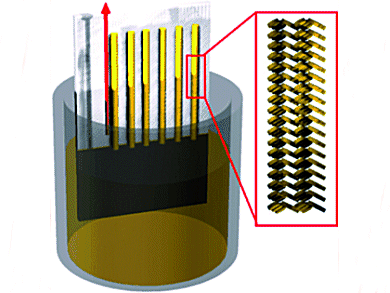Dip-coating could become an interesting route to generate unique microstructures of organic semiconductors on a large scale for applications in organic field-effect transistors (OFETs).
Scientists at the Max Planck Institute for Polymer Research, Mainz, Germany, have applied a simple dip-coating method to control the organization of small organic molecules with semiconducting properties on a surface. W. Pisula, K. Müllen and colleagues describe the fabrication of long-range well-aligned fibers from a soluble heterotriangulene derivative using this technique.
They explain that the introduction of such aligned fibrous microstructures into OFETs is currently under investigation.
- Dip-Coating-Induced Fiber Growth of a Soluble Heterotriangulene,
W. Pisula, S. Wang, M. Kivala, I. Lieberwirth, K. Kirchhoff, X. Feng, K. Müllen,
ChemPhysChem 2011, 12.
DOI: 10.1002/cphc.201100199




